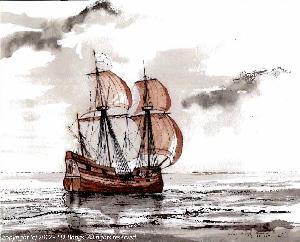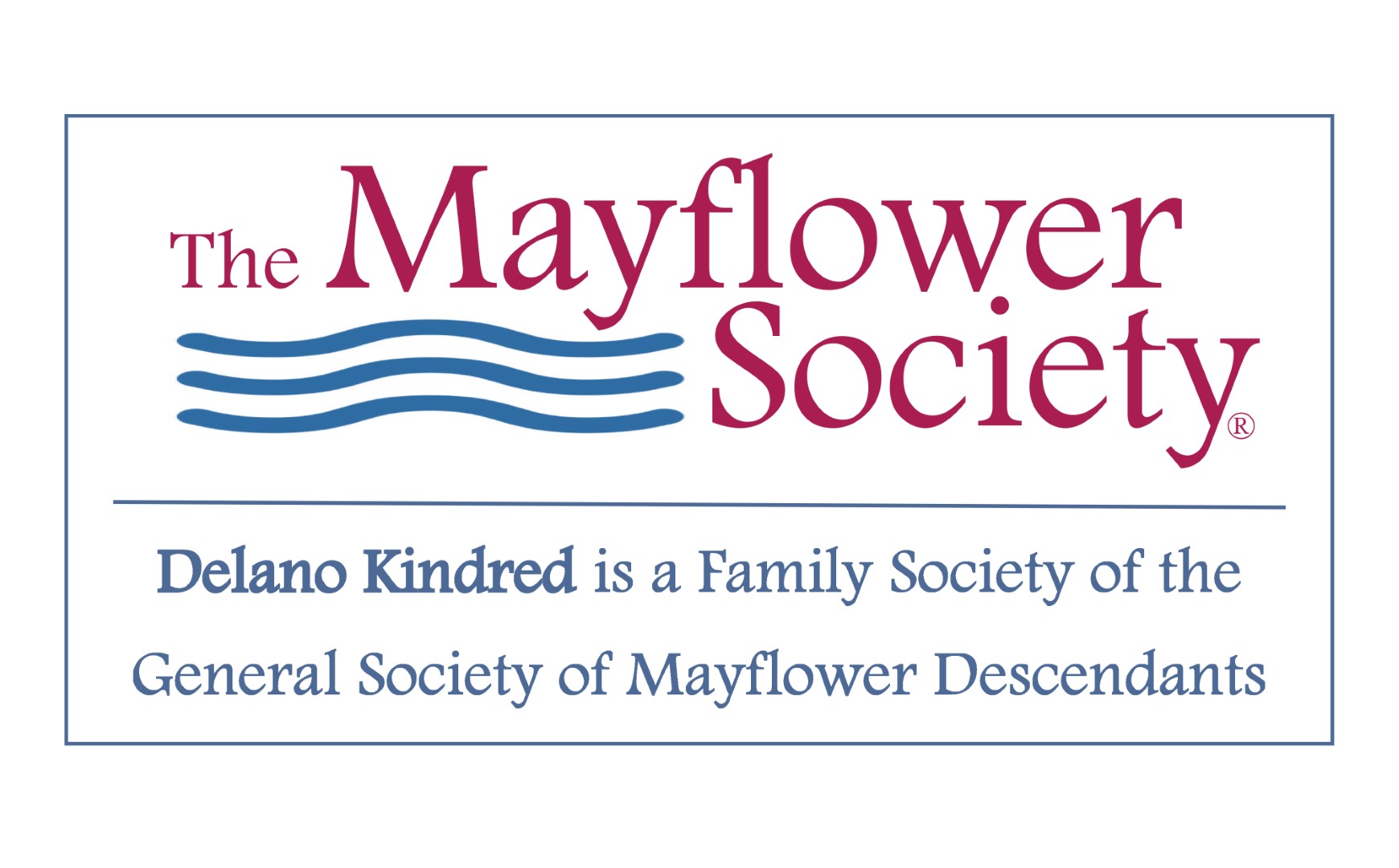
Records of Vrouwekerk (Church of Our Lady) in Leiden, Holland list the baptism of "Philippe de Lannoy" on 7 December 1603. He was the son of Jean/Jan de Lannoy and his wife, Marie Mahieu. Accompanying the family as a witness to the baptism was Francois Kock (Francis Cooke) who was married to Marie's younger sister, Hester.
Philippe was Dutch by birth, but his parents' families originated in the province of French-speaking Flanders. Jean de Lannoy was baptized on 9 May 1575 at St. Christophe Catholic Church in Tourcoing. He was one of seven known children of Guilbert de Lannoy and Jeanne du Bus who lived in the Tourcoing district of Verdequeue. While the name "de Lannoy" indicates an ancestor originally had come from Lannoy, another town in Flanders, no other information about their ancestry has been found.
Marie Mahieu was the daughter of Jeanne Mahieu. Her father was probably named Jacques. They too originally came from Flanders, living in the towns of Armentieres, Houpelyne, Lille and Bondues.
Flanders was one of 17 provinces of the Spanish Netherlands, then ruled by the King of Spain. As Calvinism spread across the provinces, staunchly Catholic KIng Philip II of Spain aggressively and brutally fought to eradicate it. We don't know when the de Lannoy and Mahieu families converted to Protestantism, but both families fled prosecution in their respective towns around 1579, sailed across the English Channel and settled in Canterbury, England. The two families likely met in Canterbury where each lived for about a dozen years.
On 10 June 1590, a "Jacques Mahieu" and his wife (name not recorded) were received into the Leiden Walloon Church with a letter of introduction dated 30 April 1590 from the Walloon Church in London. These were likely Marie's parents, as the Mahieu family moved to Leiden, in the province of Holland, around this time.
The following year, the de Lannoy family arrived in Leiden as well. And on Easter Sunday in 1591, Guilbert, Jeanne and their daughter, Marguerite, were received as members of the Walloon Church. The Vrouwekerk, one of Leiden's three medieval churches, was assigned to this congregation.
"Walloon" was a term of nationality for natives from the region of Wallonia. In the 16th and 17th centuries, Walloon Churches were Protestant churches for those who spoke French, including those from other parts of the Spanish Netherlands such as Flanders. Through the years, various writers have identified Philippe as Walloon and Huguenot (Protestant from France). He was neither, but his family did attend the French-speaking Walloon Church.
Jean de Lannoy and Marie Mahieu may have met in Canterbury as children. They attended the same church there, and their parents likely knew each other. On 14 October 1595, Jean and Marie confessed their faith and joined the Vrouwekerk congregation. They were betrothed on 13 January 1596, and their marriage probably took place several weeks later.
We don't know when their first child was born. Vrouwewerk baptismal records only exist from 1599 onward. Their first known child was a daughter, Jeanne, baptized on 18 March 1601. Philippe followed in 1603.
Little is known of Philippe's early life in Leiden. A week after his baptism, a "child of Jan de Lano" died of the plague and was buried. While there were several others named Jan de Lano (Jean de Lannoy) in Leiden, none of the others known fits this record. So, it's possible this was Philippe's sister, Jeanne. His father may have contracted the plague around the same time. He died within six months of Philippe's baptism.
Marie Mahieu de Lannoy married Robert Mannoo, a woolcomber from Namur, on 6 March 1605. The last reference to her was 22 April 1611 when she served as a witness for the betrothal of her sister, Francoise. Whether Marie lived to see her son depart for a new world is unknown.
In July 1621, Philippe de Lannoy boarded Fortune in London. Fortune was the second English ship with passengers destined for Plymouth Colony. Very little is known about her voyage, except it took about four months, making landfall at Cape Cod on 9 November 1621. It took them several weeks to find Plymouth, arriving in early December. Here, Philippe joined his uncle and cousin, Francis and John Cooke, who had arrived on Mayflower in 1620.
Plymouth was basically a farming society. Outside the palisade were fields where they planted crops that were their main source of food. At first, the colonists farmed together. In late 1623, Governor William Bradford and the Colony's government decided to give every man, woman and child the use of one acre of land to be cultivated as they wished, with the understanding each could keep whatever they grew. Land still belonged to the Colony, and they still cultivated the greater common lands together for the Adventurers (investors in England), but this change inspired great industry among the settlers. Philippe and Mose Simonson were granted two acres together on the north side of town between the first and second brooks.
Governor Bradford believed owning one's own land was the work incentive needed to make the Plymouth Colony successful, and he was eager to sever ties with the London Adventurers. In October 1626, several Colony leaders and the Adventurers negotiated a new agreement. For £1800 (£200 per year for nine years), the Adventurers sold their interests in the plantation to the settlers. And in 1627, common possession of all assets ended.
Governor Bradford called the planters together into General Court and proposed all adult men who were either heads of households or single free men of ability should share in the division of property. He also proposed a single man receive one share and a family head receive one share for every member of their household. Each share would entitle that person to a certain amount of property when the assets were divided. And the amount of debt owned to the Adventurers by each man would be based on the number of shares they held. Fifty-eight men shared in the division of assets in 1627 and were subsequently known as "Purchasers" or "Oldcomers." Philippe was one of these Purchasers.
The following year, a small group of men agreed to be responsible for the Colony's debt in exchage for a six-year monopoly on the Indian trade. Another element of the agreement was Purchasers, as a group, would have advantageous rights to subsequent divisions of land. Philippe would benefit from these favorable land rights in years to come, acquiring lands he passed on to several of his sons.
The Colony divided the livestock in June 1627. Residents were grouped into 12 companies or "lots," totaling 156 people. Each lot consisted of 13 individuals. Philippe was in the first lot that went ot Francis Cooke and included his wife, family and several others
The demand for privately-owned land was profound, and Governor Bradford and the Colony's government agreed to grand land to most settlers. Single men received 20 acres, and heads of families received 20 acres for every family member. In June 1627, about a third of the colonists, including Philippe, received land north of Plymouth along the coast. This area would become the town of Duxbury.
Philippe's property appears to have been the furthest north at this time, nestled between Stony Brook (Duck Hill River today) to the north and the Blue Fish River to the south. This waterway made Philippe's land a prime location. Here, he would become a farmer and fisherman.
In August 1627, "Palipp deLanoy" sold one acre of land lying on the north side of Plymouth between the first and second brooks to Stephen Dean for £4. This was the land assigned to him in 1623, and it was the very first recorded land sale in the Colony after the institution of private property.
On 19 December 1634, Philippe married Hester Dewsbury. No other account of their marriage (or her) survives. Philippe and Hester had six known children. Unfortunately, no records survive documenting their births or baptisms. All presumably were born in Duxbury. Based on marriage dates and other information, the following lists their estimated birth year and order:
We don't know when Hester died, but Philippe married the widow Mary Pontus Glass sometime between 4 March 1652/53 and 17 January 1653/54. Together, they had three more children:
Philippe was a trusted and respected member of his town and Colony. He joined the Plymouth church at his "age of discerning" (21 years). His name appeared on the first-recorded list of freemen of the Colony, and freemen were expected to perform duties in support of their community. Philippe served in his local militia, helped lay out roads, settled land dispputes and estates and was appointed to no less than 20 juries during his lifetime.
Philippe de Lannoy died sometime between 22 August 1681 and 4 March 1681/82. He left no will, but his sons, Thomas and Samuel, settled his estate. There is no record of his burial, but it's believed he rests in Duxbury's Old Burying Ground (Myles Standish Burying Ground), as was the custom. Nothing more is known of Mary Pontus Glass de Lannoy.
An extraordinary tome documenting the DELANO family in America entitled "The Genealogy, History and Alliances of the American House of Delano, 1621-1899" was published in 1899. It is arranged in two "books" and is commonly known as the "GHAAHD".
The first "book" covers the history of the Delano family as it was believed to be in 1899, while the second "book" contains the genealogical information of each family entity with known biographical and historical information, beginning with Philippe (Philip) Delano and his family.
For further details about the GHAAHD and to view or download this volume for reference purposes, click here.
